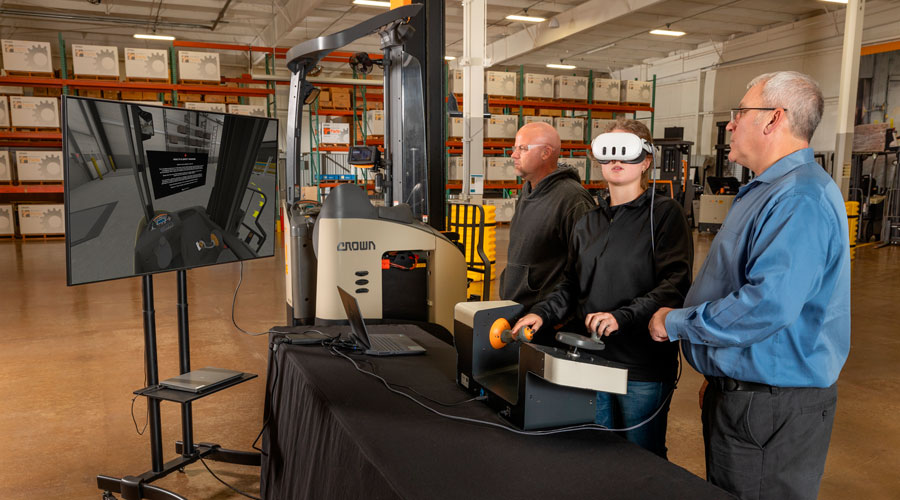Strategic Use of Virtual Reality in Forklift Operator Training

Virtual reality (VR) simulations provide an immersive environment for training forklift operators. By simulating real-world scenarios, VR training allows operators to demonstrate their competency in a controlled setting without the risk of accidents or equipment damage.
Immersive learning is adding a new dimension to the training of forklift operators, bringing numerous benefits to the process. You can learn more about these benefits in our previous blog. The effectiveness of VR simulation is dependent on how it is used within the context of a training system. Rather than open-ended practice sessions, Crown uses VR at multiple points in its 11-step Demonstrated Performance® (DP) operator training program. These steps allow for short, focused VR training scenarios corresponding to specific training skills.
Focused Application
For each step in Demonstrated Performance training, operators must perform a set of critical skills before progressing to the next, more advanced step. For example, the first step involves an introduction to the forklift and its operations, controls and capacities. Depending on the forklift, trainees learn and demonstrate how to use multi-function handle controls, lift and lower forks, reach and retract forks and use tilt and side-shift functions. Without VR, these skills are typically demonstrated and reviewed using a forklift with a disconnected battery, for safety reasons. Trainees demonstrate tasks to the trainer but cannot experience how the forklift responds to their actions. This feedback is important when performing certain actions, such as raising and lowering the forks at a controlled speed using small movements of the control handle.
Targeted Sensory Feedback
Using VR to learn and demonstrate these skills enables trainees to experience the lift truck responses associated with each operator input and helps them build the coordination, spatial awareness, and timing associated with operating a live forklift in an actual application.
The VR component can provide visual and sensory feedback to the trainee allowing them to experience the handling of different loading scenarios, maneuvering in tight spaces and using the forklift controls without the consequences of operating the lift truck incorrectly.
Instead of using VR like a gaming system for extensive practice time, Crown recommends that VR sessions are tied to individual steps in the Demonstrated Performance learning program and therefore kept brief to help focus on specific skills. This limits wear time of the VR headset, which can help some trainees avoid the possibility of experiencing motion sickness.
Other steps in the Demonstrated Performance training process that benefit from the strategic use of VR simulation include driving and turning in both forward and reverse, as well as plugging and braking. VR simulation is also used when operators learn to engage a pallet, handle loads at height and turn into pallets at 90 degrees. All of these skills are readily augmented by adding a VR training component to complement real-world demonstration and hands-on learning.
Enhance Your Training Process
Crown’s DP MoveSafe forklift operator training system includes a mix of classroom, hands-on and optional VR learning that provides a comprehensive approach to developing skills. Companies interested in the VR option can purchase the VR system, which includes the VR headset, software, lift truck controls and floorboard, and ongoing support. The system can be integrated into a learning management system for performance tracking. If you are considering adding VR simulation to forklift operator training at your organization, visit the Demonstrated Performance training programs page on crown.com to learn more.